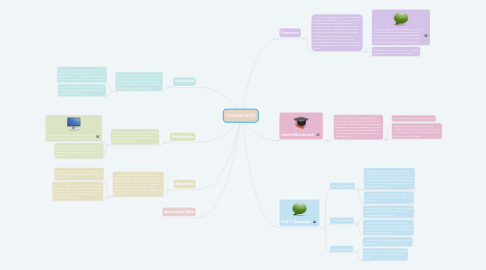
1. Summative
1.1. Summative assessments are used to evaluate student understanding, usually done at the end of a unit. The data is compared against a specific standard or benchmark to gauge mastery.
1.1.1. State "content based assessment" that is given after a grading period is over. It would cover all of the learning that should have been covered in the 6 weeks prior.
1.1.2. An end of unit test, maybe on a reading passage that utilizes strong examples for drawing conclusions.
2. Performance
2.1. A performance assessment evaluates the progress that a student has made on a particular task. It's intended to increase their understanding.
2.1.1. Students could come up with a Kahoot! or other online game to quiz each other.
2.1.2. Students could work with a partner or group to get out of a digital or "physical" break out room, drawing conclusions to solve riddles.
3. Diagnostic
3.1. A diagnostic assessment is usually a pre-assessment that can be used by a teacher to help build objectives and details within a lesson. Primarily used to diagnose student difficulties and to guide lesson planning, it incorporates class strength and weaknesses.
3.1.1. the class can be given a pretest with scenarios to help guide instruction, based on results.
3.1.2. Prior to starting a lesson, a teacher can ask questions about what inferences students can gather from pictures or things that they have read to gather the knowledge of the majority of the class.
4. Assessment Data
5. Formative
5.1. A formative assessment provides feedback throughout a module, to gauge students' understanding of smaller chunks of concepts. These allow teachers to adjust instruction to help students achievement. Formative assessments are part of a cycle that continues throughout learning. Teachers gather evidence of learning (formative assessment), evaluate evidence, give feedback, adjust instruction, and lastly, repeat.
5.1.1. Informal: Whole group discussion. Ask each student to share a fact or an opinion that they have about a group activity. Student must state if they have a fact or an opinion to share before they give their statement.
5.1.2. Exit ticket at the end of a lesson to check comprehension of a daily objective.
6. Interim/Benchmark
6.1. Interim or benchmark assessments are fixed assessments given at specific times (like at the end/beginning of the 6 weeks, beginning of the year, middle of the year, or end of the year), evaluating students against specific standards/objectives and learning goals.
6.1.1. Standardized tests given by the state
6.1.2. Assessments given at the beginning, middle, and end of the year to test growth and compare it to other students that are the same age and grade.
7. H.O.T. Questions
7.1. Opening Questions
7.1.1. "Sometimes, authors don't always write everything that a character is thinking or feeling. We do it too! If I were to furrow my brow and make a frown, what would you think I am feeling? Can you guess? Even if I don't say it out loud..."
7.1.2. "When we draw conclusions, we take what we already know and we have to look for what else?"
7.2. Guiding Questions
7.2.1. "Look at this picture guys! What clues does the picture have that shows how the character might be feeling?"
7.2.2. "Would you want to play soccer all the time if you were not good at it? What clues do we have that tell us that our character might be good at soccer?"
7.3. Closing Questions
7.3.1. "Where are some places we can find clues in our stories?"
7.3.2. "How can we use these skills, drawing conclusions, in other places than our book?"

